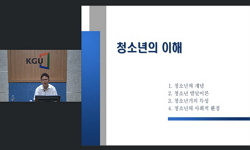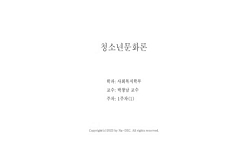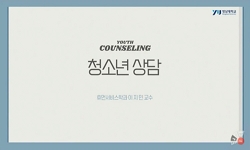본 연구는 형사책임연령 하향에 대한 청소년의 인식을 네 가지 쟁점(형사책임연령 하향 찬성, 낙인효과에 대한 우려, 범죄유형에 따른 형사처벌 여부 결정, 자녀대신 보호자 처벌)을 중심으...
http://chineseinput.net/에서 pinyin(병음)방식으로 중국어를 변환할 수 있습니다.
변환된 중국어를 복사하여 사용하시면 됩니다.
- 中文 을 입력하시려면 zhongwen을 입력하시고 space를누르시면됩니다.
- 北京 을 입력하시려면 beijing을 입력하시고 space를 누르시면 됩니다.
https://www.riss.kr/link?id=T16667121
- 저자
-
발행사항
서울 : 경희대학교 대학원, 2023
- 학위논문사항
-
발행연도
2023
-
작성언어
한국어
- 주제어
-
DDC
641-A 판사항(22)
-
발행국(도시)
서울
-
기타서명
Adolescents' Attitudes toward the Age of Criminal Responsibility
-
형태사항
v, 61 p. : 삽화 ; 26 cm
-
일반주기명
경희대학교 논문은 저작권에 의해 보호받습니다.
지도교수: 김연하
참고문헌: p. 45-53 -
UCI식별코드
I804:11006-200000658972
- 소장기관
-
0
상세조회 -
0
다운로드
부가정보
국문 초록 (Abstract)
이에 본 연구에서는 전국 초.중.고등학교에 재학 중인 만 10~18세 청소년 650명을 연구대상으로 선정하였다. 청소년들은 형사책임연령 하향과 관련된 네 가지 쟁점에 얼마나 동의하는지와 학교폭력피해 경험 및 비행행동 경험을 묻는 설문에 응답하였다. 성인 자료의 경우, 본 연구와 동일한 척도로 2022년 법무부에서 실시한 형사책임연령 하향에 대한 인식조사의 데이터를 확보하여 연구 목적에 맞게 가공하여 활용하였다.
수집된 자료는 SPSS 23.0 Program을 사용하여 분석하였다. 분석 방법은 다음과 같다. 첫째, 연구대상의 일반적인 특성을 분석하기 위해 빈도와 백분율을 산출하였으며 연구 도구의 신뢰도 검증을 위해 신뢰도 계수(Chronbach‘s α)를 측정하였다. 두 번째로, 주요 연구 변인들의 일반적인 경향 및 관련성을 알아보기 위하여 평균, 표준편차, 상관관계를 산출하였다. 셋째, 청소년의 인구사회학적 변인에 따른 형사책임연령 하향에 대한 인식 차이와 청소년 집단과 성인 집단의 인식 차이를 살펴보기 위해 차이검증(t-test)을 실시하였다. 넷째, 연구대상의 학교폭력피해 경험 및 비행행동 경험과 형사책임연령 하향에 대한 인식의 관계를 알아보기 인구사회학적 변인을 통제한 위계적 회귀분석을 실시하였다.
본 연구의 주요 결과는 다음과 같다. 첫째 청소년의 인구사회학적 특성에 따른 형사책임연령 하향에 대한 인식을 살펴본 결과, 학교성적이 높을수록 형사책임연령 하향에 더 찬성하였다. 만 14세 미만일수록 연령기준 하향으로 인한 낙인효과를 더욱 우려하였다. 남학생이 여학생보다, 학교 성적이 높을수록, 가정 소득수준이 높을수록, 부모의 최종학력 수준이 높을수록 범죄유형에 따른 형사처벌여부 결정에 더 찬성하였다. 여학생이 남학생보다 범죄를 저지른 촉법소년의 잘못에 대해 보호자를 대신 처벌하는 것에 더 찬성하였다. 둘째, 청소년과 성인의 형사책임연령 하향에 관한 인식 차이를 살펴본 결과, 성인이 청소년보다 형사책임연령 하향에 대해서 더 찬성하고, 범죄를 저지른 촉법소년의 잘못에 대해 보호자를 대신 처벌하는 것에 더 찬성하였다.
셋째, 청소년의 학교폭력피해 경험과 형사책임연령 하향에 관한 인식의 관계를 살펴본 결과, 학교폭력피해 경험이 많을수록 형사책임연령 하향에 덜 찬성하였고, 범죄유형에 따라 형사처벌 여부를 결정하는 데에 더 찬성하였다. 넷째, 청소년의 비행행동 경험과 형사책임연령 하향에 관한 인식의 관계를 살펴본 결과, 비행행동 경험이 많을수록 형사책임연령 하향에 덜 찬성하였다.
본 연구에서는 기존의 연구와 달리 형사책임연령 하향의 직접 대상자인 청소년을 대상으로 그 의견을 조사하였고, 그 예측요인을 규명하였다는 데 의의를 둘 수 있다. 또한, 형사책임연령 하향에 대한 세대 간 인식 차이가 존재함을 살펴봄으로써 성인이 주체가 되어 이뤄지는 입법 및 정책 설계과정에서 청소년의 입장도 고려해야 할 필요성을 제시하였다.
본 연구는 형사책임연령 하향에 대한 청소년의 인식을 네 가지 쟁점(형사책임연령 하향 찬성, 낙인효과에 대한 우려, 범죄유형에 따른 형사처벌 여부 결정, 자녀대신 보호자 처벌)을 중심으로 살펴보고, 성인의 인식과 차이가 있는지 살펴보았다. 또한, 청소년의 학교폭력피해 경험 및 비행행동 경험이 형사책임연령 하향에 대한 인식과 관련이 있는지도 검증하였다.
이에 본 연구에서는 전국 초.중.고등학교에 재학 중인 만 10~18세 청소년 650명을 연구대상으로 선정하였다. 청소년들은 형사책임연령 하향과 관련된 네 가지 쟁점에 얼마나 동의하는지와 학교폭력피해 경험 및 비행행동 경험을 묻는 설문에 응답하였다. 성인 자료의 경우, 본 연구와 동일한 척도로 2022년 법무부에서 실시한 형사책임연령 하향에 대한 인식조사의 데이터를 확보하여 연구 목적에 맞게 가공하여 활용하였다.
수집된 자료는 SPSS 23.0 Program을 사용하여 분석하였다. 분석 방법은 다음과 같다. 첫째, 연구대상의 일반적인 특성을 분석하기 위해 빈도와 백분율을 산출하였으며 연구 도구의 신뢰도 검증을 위해 신뢰도 계수(Chronbach‘s α)를 측정하였다. 두 번째로, 주요 연구 변인들의 일반적인 경향 및 관련성을 알아보기 위하여 평균, 표준편차, 상관관계를 산출하였다. 셋째, 청소년의 인구사회학적 변인에 따른 형사책임연령 하향에 대한 인식 차이와 청소년 집단과 성인 집단의 인식 차이를 살펴보기 위해 차이검증(t-test)을 실시하였다. 넷째, 연구대상의 학교폭력피해 경험 및 비행행동 경험과 형사책임연령 하향에 대한 인식의 관계를 알아보기 인구사회학적 변인을 통제한 위계적 회귀분석을 실시하였다.
본 연구의 주요 결과는 다음과 같다. 첫째 청소년의 인구사회학적 특성에 따른 형사책임연령 하향에 대한 인식을 살펴본 결과, 학교성적이 높을수록 형사책임연령 하향에 더 찬성하였다. 만 14세 미만일수록 연령기준 하향으로 인한 낙인효과를 더욱 우려하였다. 남학생이 여학생보다, 학교 성적이 높을수록, 가정 소득수준이 높을수록, 부모의 최종학력 수준이 높을수록 범죄유형에 따른 형사처벌여부 결정에 더 찬성하였다. 여학생이 남학생보다 범죄를 저지른 촉법소년의 잘못에 대해 보호자를 대신 처벌하는 것에 더 찬성하였다. 둘째, 청소년과 성인의 형사책임연령 하향에 관한 인식 차이를 살펴본 결과, 성인이 청소년보다 형사책임연령 하향에 대해서 더 찬성하고, 범죄를 저지른 촉법소년의 잘못에 대해 보호자를 대신 처벌하는 것에 더 찬성하였다.
셋째, 청소년의 학교폭력피해 경험과 형사책임연령 하향에 관한 인식의 관계를 살펴본 결과, 학교폭력피해 경험이 많을수록 형사책임연령 하향에 덜 찬성하였고, 범죄유형에 따라 형사처벌 여부를 결정하는 데에 더 찬성하였다. 넷째, 청소년의 비행행동 경험과 형사책임연령 하향에 관한 인식의 관계를 살펴본 결과, 비행행동 경험이 많을수록 형사책임연령 하향에 덜 찬성하였다.
본 연구에서는 기존의 연구와 달리 형사책임연령 하향의 직접 대상자인 청소년을 대상으로 그 의견을 조사하였고, 그 예측요인을 규명하였다는 데 의의를 둘 수 있다. 또한, 형사책임연령 하향에 대한 세대 간 인식 차이가 존재함을 살펴봄으로써 성인이 주체가 되어 이뤄지는 입법 및 정책 설계과정에서 청소년의 입장도 고려해야 할 필요성을 제시하였다.
다국어 초록 (Multilingual Abstract)
according to the type of crime, and punishment of guardians instead of adolescents. The differences in attitudes were examined between adolescents and adults. It was also verified whether adolescents' experience of school violence and delinquent behavior were related to their attitudes towards the age
of criminal responsibility.
A total of 650 adolescents between 10 and 18 ages were participants in this study. Adolescents were asked how much they agreed with the four issues related to the age of criminal responsibility and their experience of school violence and delinquent behavior. For the comparison with adult data, the survey data on attitudes toward the age of criminal responsibility conducted by the Ministry of Justice in 2022 using the same scale as this study were employed
The collected data were analyzed using the SPSS 23.0 Program. Frequencies and percentages were calculated to examine the general characteristics of the participants. Internal consistencies (Chronbach's α) of scales were measured to verify the reliability of the research instruments. The average, standard deviation, and correlation were calculated to determine the main study variables' general trend and relevance. A series of t-tests were conducted to examine the difference in attitudes towards the age of criminal responsibility according to
socio-demographic variables. The differences in the attitudes between the youth and adult groups were also examined with t-tests. A series of hierarchical regression analyses were conducted to find the relationship between the experience of school violence and delinquent behavior and the attitudes towards
the age of criminal responsibility.
The results of this study are as follows. First, the higher the school grades, the more in favor of lowering the age of criminal responsibility. The younger, the more concerned about the stigma effect caused by lowering the age standard. Male students favored the decision on criminal punishment according to the type of crime over female students. The higher the school grades, the higher the family income level and the higher the parents' level of education were more in favor of the decision on criminal punishment according to the
type of crime. Female students favored the punishment of guardians instead of adolescents more than male students. Second, the difference was found in the attitudes toward the age of criminal responsibility between adolescents and adults. Adults favored lowering the age of criminal responsibility more than
adolescents and punishing guardians instead of adolescents.
Third, adolescents' experience of victimization by school violence predicted their attitudes towards the age of criminal responsibility. The more victimization by school violence, the less in favor of lowering the age of criminal responsibility. The more victimization by school violence, the more in favor of imposing criminal punishment according to the type of crime.
Fourth, adolescents' experience of delinquent behavior predicted their attitudes towards lowering the age of criminal responsibility. The more conducted delinquent behavior, the less in favor of lowering the age of criminal responsibility.
This study is meaningful in that it investigated the opinions of adolescents, who are directly subject to lowering the age of criminal responsibility, and identified the predictive factors. In addition, the difference in attitudes between generations on the age of criminal responsibility proposes the need to reflect
adolescents' ideas and positions in designing legislation and policies on the criminal responsibility of adolescents.
This study examines adolescents' attitudes toward the age of criminal responsibility. It focuses on four issues; lowering the age of criminal responsibility, concern about the stigma effect, imposing criminal punishment according to the type of crime,...
This study examines adolescents' attitudes toward the age of criminal responsibility. It focuses on four issues; lowering the age of criminal responsibility, concern about the stigma effect, imposing criminal punishment
according to the type of crime, and punishment of guardians instead of adolescents. The differences in attitudes were examined between adolescents and adults. It was also verified whether adolescents' experience of school violence and delinquent behavior were related to their attitudes towards the age
of criminal responsibility.
A total of 650 adolescents between 10 and 18 ages were participants in this study. Adolescents were asked how much they agreed with the four issues related to the age of criminal responsibility and their experience of school violence and delinquent behavior. For the comparison with adult data, the survey data on attitudes toward the age of criminal responsibility conducted by the Ministry of Justice in 2022 using the same scale as this study were employed
The collected data were analyzed using the SPSS 23.0 Program. Frequencies and percentages were calculated to examine the general characteristics of the participants. Internal consistencies (Chronbach's α) of scales were measured to verify the reliability of the research instruments. The average, standard deviation, and correlation were calculated to determine the main study variables' general trend and relevance. A series of t-tests were conducted to examine the difference in attitudes towards the age of criminal responsibility according to
socio-demographic variables. The differences in the attitudes between the youth and adult groups were also examined with t-tests. A series of hierarchical regression analyses were conducted to find the relationship between the experience of school violence and delinquent behavior and the attitudes towards
the age of criminal responsibility.
The results of this study are as follows. First, the higher the school grades, the more in favor of lowering the age of criminal responsibility. The younger, the more concerned about the stigma effect caused by lowering the age standard. Male students favored the decision on criminal punishment according to the type of crime over female students. The higher the school grades, the higher the family income level and the higher the parents' level of education were more in favor of the decision on criminal punishment according to the
type of crime. Female students favored the punishment of guardians instead of adolescents more than male students. Second, the difference was found in the attitudes toward the age of criminal responsibility between adolescents and adults. Adults favored lowering the age of criminal responsibility more than
adolescents and punishing guardians instead of adolescents.
Third, adolescents' experience of victimization by school violence predicted their attitudes towards the age of criminal responsibility. The more victimization by school violence, the less in favor of lowering the age of criminal responsibility. The more victimization by school violence, the more in favor of imposing criminal punishment according to the type of crime.
Fourth, adolescents' experience of delinquent behavior predicted their attitudes towards lowering the age of criminal responsibility. The more conducted delinquent behavior, the less in favor of lowering the age of criminal responsibility.
This study is meaningful in that it investigated the opinions of adolescents, who are directly subject to lowering the age of criminal responsibility, and identified the predictive factors. In addition, the difference in attitudes between generations on the age of criminal responsibility proposes the need to reflect
adolescents' ideas and positions in designing legislation and policies on the criminal responsibility of adolescents.
목차 (Table of Contents)
- < 목 차 >
- 국문초록 ⅳ
- < 목 차 >
- 국문초록 ⅳ
- I. 서 론 1
- 1. 연구의 필요성 및 목적 1
- 2. 연구 문제 5
- 3. 용어정리 6
- (1) 촉법소년 6
- (2) 형사책임연령 하향 6
- (3) 낙인효과에 대한 우려 7
- (4) 범죄유형에 따른 형사처벌여부 결정 7
- (5) 자녀 대신 보호자 처벌 7
- (6) 학교폭력피해 경험 8
- (7) 비행행동 경험 8
- Ⅱ. 이론적 배경 9
- 1. 형사책임연령 하향에 대한 쟁점 9
- 1) 형사책임연령 하향 9
- 2) 낙인효과 11
- 3) 범죄유형에 따른 형사처벌여부 결정 12
- 4) 자녀 대신 보호자 처벌 14
- 2. 형사책임연령 하향에 대한 인식에 영향을 미치는 요인 16
- 1) 학교폭력피해 경험 16
- 2) 비행행동 경험 17
- Ⅲ. 연구 방법 19
- 1. 연구 대상 19
- 2. 연구 도구 21
- 1) 촉법소년 형사책임연령 하향에 대한 인식 21
- 2) 학교폭력피해 경험 22
- 3) 비행행동 경험 23
- 3. 연구 절차 24
- 1) 예비조사 24
- 2) 본 조사 24
- 4. 자료 처리 24
- Ⅳ. 연구 결과 26
- 1. 형사책임연령 하향에 대한 청소년 인식의 일반적 경향 및 인구사회학적 특성에 따른 인식 차이 26
- 1) 형사책임연령 하향에 대한 청소년의 인식 및 주요 변인의 일반적 경향 26
- 2) 청소년의 학교폭력피해 경험, 비행행동 경험 및 형사책임연령 하향 인식 간의 상관관계 27
- 3) 청소년의 인구사회학적 특성에 따른 형사책임연령 하향에 대한 인식 차이 28
- 4) 촉법소년 형사책임연령 하향에 대한 청소년과 성인의 인식 차이 30
- 2. 청소년의 학교폭력피해 경험과 형사책임연령 하향에 대한 인식 32
- 3. 청소년의 비행행동 경험과 형사책임연령 하향에 대한 인식 34
- Ⅴ. 논의 및 결론 36
- 참 고 문 헌 45
- ABSTRACT 54
- 부록 57












